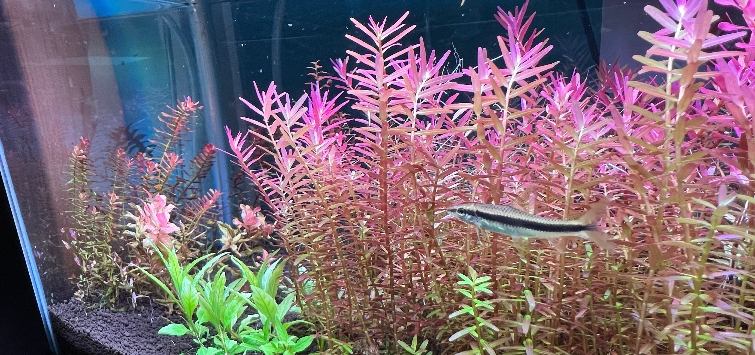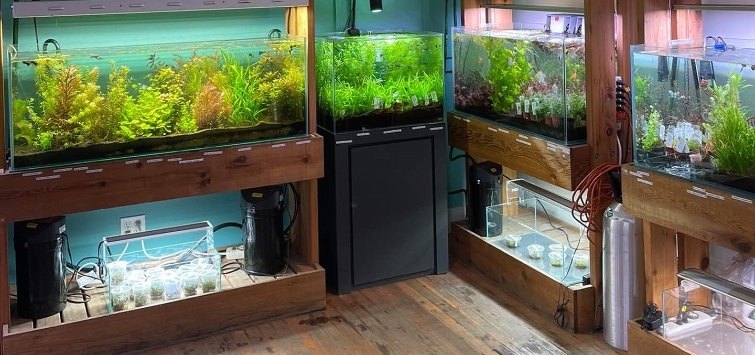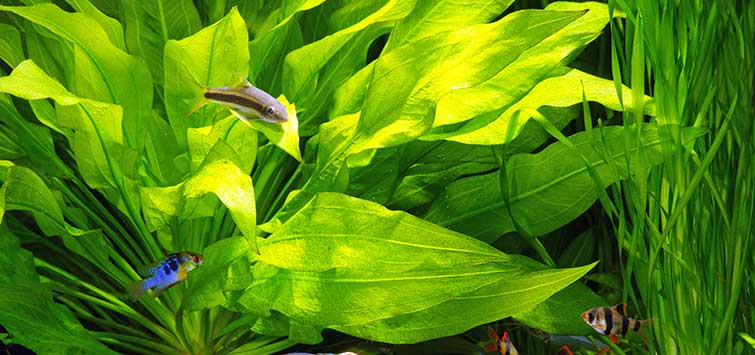How to Grow Aquarium Plants: Tips & Tricks
Steve Waldron
“Before you can run, you have to learn how to walk.” To borrow that age-old piece of wisdom for the planted aquarium hobby, before you can aquascape, you have to learn how to grow aquarium plants. Aquascaping is the visionary, creative, poetic aspect of the planted aquarium, whereas horticulture is the scientific, practical, and logistic aspect.Aquascaping and horticulture blend together like the yin and yang of a beautiful underwater garden. At my aquascaping shop in Seattle, Aquarium Zen, I frequently come across well-meaning newbies who have artistic visions of underwater bonsai trees overlooking miniature valleys of pearling HC Cuba, dotted with delicate groves of Pogostemon helferi, but who have not yet mastered the horticultural requirements of growing even the most basic Ludwigia.
Very detailed aquascapes often require a significant investment in quality lighting, carbon dioxide (CO2) systems, active substrates, aquarium fertilizers, and expensive hardscape material. It can be frustrating when the money is spent but the hoped-for results fail to materialize. I believe this is why so many aquarium systems end up collecting dust in the garage or wind up being sold at a cut rate. My goal is to help foster the interests of my clients in a sustainable way that will keep them engaged and successful in this hobby for a lifetime.
So, before we can really run with Rotala or Riccia in our aquascapes, we often have to walk with easy plants like Anubias and Java fern for a while as we develop our instinct and technique for growing aquarium plants. I slowly struggled with this dichotomy for years myself before I felt I really had the knowledge base and experience to realize my creative visions.
As I look back, I can see the time I spent doing research and developing hands-on experience with aquarium plant propagation really propelled my skills and capacity to execute the aquascapes of my dreams. I hope to detail a few of my favorite techniques to help you achieve the horticultural mastery to create the aquascape your inner planted aquarium artist yearns for.
The Intersection of Science, Art, and Nature

Successful underwater horticulture is a practice that blends science, art, nature observation, and patience. The operative word here is “practice.” There aren’t any real cookie-cutter sort of recommendations for developing the practice of aquatic plant horticulture, as there are so many unique environmental variables such as water quality, fertilizer strategies, and variations in lighting technology that will affect your success. So, to sharpen our skills and to develop mastery, we need time, we need an experimental mindset, and we need a place to practice.
I advocate for a dedicated practice space much like a practitioner of martial arts will return to their dojo or the painter will return to their studio. The ideal practice space for a budding aquatic horticulturist is the farm tank. A farm tank is a unique sort of aquarium where we are purely focused on the needs of plants and nothing else.
Often, in an aquascape, we need to find a balance between the requirements of our delicate animal inhabitants and our plants. But sometimes these needs are in conflict.
For example, aquarium plants thrive in the presence of dissolved carbon dioxide, whereas even slightly too much CO2 can asphyxiate fish and shrimp. Certain nutrients such as nitrogen are essential in getting our plants to grow but act as toxins to animal life when the concentrations are too high. In the farm tank, the demands of the animals can be excised, and we can do wild experiments with fertilizers and carbon dioxide that might otherwise stress or even kill our fish and shrimp friends.
The farm tank is all about the plants and nothing else. This is not the space to perfect your stone or wood hardscape layout. In the farm tank, we want to maximize all available real estate for spreading roots, reaching stems, and unfurling leaves. The farm tank is a laboratory to observe the interactions of light, aqua-soil, water, nutrients, and how tweaking those variables fuels success for growing aquarium plants.
Enjoying TFH Magazine? Subscribe Today!
Cultivating Rarities
In the ancient past of aquascaping (say, about a decade ago), many of the plants that are commonly available today from commercial nurseries were very rare and only made available through plant clippings passed from one aquarist’s hand to another. The farm tank was the space you utilized to grow out those clippings into larger plants that could then be used creatively in the aquascape.If for some reason, your aquascape failed and algae prevailed, you could always return to your farm tank for some fresh material to start the creative process all over again. Clippings from the farm tank could be sold and traded to other aquascapers, offering a financial return on the investment in hardware and other supplies.
Even though I feel pretty confident in my aquatic plant horticultural practice, I still have many farm tanks in my life. At Aquarium Zen, we have an array of standard aquariums that shift between aquatic-plant farm tanks and temporary holding aquariums for fish breeding projects as needed. We use our farm tanks as an auxiliary space to cultivate those novelties and rarities that have not yet reached the commercial farms that supply the bulk of the plants we sell.
Aquatic Horticultural Strategies

With the EI method, we acknowledge that we aren’t quite certain of the precise fertilizer needs of our plants and instead dose everything in excess while flushing the whole system out with heavy water changes once a week. This way, plant growth is never stunted by the absence of a limiting nutrient.
Because our farm tanks are filled with actively growing plants (at least 60 percent of the aquarium volume is dedicated to plant biomass) and regularly refreshed with big water changes, algae is theoretically outcompeted and fails to gain a foothold. It’s the best and most economical technique I have tried for mass producing stem plants in a dedicated farm tank.
It’s important to define your goals before starting out with any endeavor, and here we see the difference between the function of the farm tank and the aquascape. In the aquascape, I don’t want my plants growing too fast, quickly oscillating between that fresh haircut look and a tangled jungle of water plants. I want a slower growth rate to hold my artistic vision longer between trimming sessions, and I don’t want to risk an algae bloom.
Therefore, a leaner fertilizer strategy is more appropriate in the aquascape, and ironically, you’ll often see more pop from high-colored species like Ludwigia and Rotala with lean water-column fertilizing. For excellent, in-depth discussions of the EI method and other fertilizer strategies, I recommend the writings and website of another aquatic plant master, the Two-Hour Aquarist, Dennis Wong—a great resource for aquascapers and aquatic plant farmers alike.
Growing Aquarium Plants Out of Water
Another favorite plant propagation technique of mine, and probably the simplest and most economical of all to execute, is learning how to grow aquarium plants out of water. While that may sound strange, many (if not most) of our aquarium plants are amphibious in nature, marginal plants growing along the edges of freshwater water bodies like lakes and streams.Periodically, these bodies of water flood over their banks and submerge the marginal plants. These resilient plants will then convert to an aquatic growth form and when the waters recede, return to a terrestrial growth structure.
Many commercial aquarium plant farms take advantage of the adaptable nature of these plants and grow their crops in greenhouses where the roots of the plants are constantly bathed in water and the vegetative growth is accelerated in the humid greenhouse air.
Besides nutrients like nitrogen and potassium, aquatic plant growth is often limited by carbon dioxide. Carbon dioxide is very limited in the aquarium, requiring a tank of pressurized gas, a regulator, and other components to deliver it at safe concentrations for the animal occupants. In the greenhouse, CO2 limitation is not an issue, as the plants can sequester all of it they need, freely, from the air.
Another benefit to this technique: Algae can’t grow on plants growing out of water. The plants grow clean, fast and are then harvested and shipped off to their various destinations in the aquarium trade.
Once in the aquarium, the plants then revert to their aquatic form, ideally. It’s a simple, elegant system for the mass propagation of plants that would otherwise require lots of water and injected CO2. While most hobbyists may not have a greenhouse at their disposal, they likely have some old fish tanks lying around or even a translucent plastic shoebox or storage tote.
Plant cuttings are simply rooted in a layer of nutrient-rich substrate, such as one of the many aqua-soils on the market, or even raw garden soil capped with gravel. A small volume of water is added to just barely cover the top of the soil line, replicating in miniature the marshy humid environments where these plants grow.
The “greenhouse” is then sealed up with the aquarium top or tote lid. The only other environmental variables required are a reasonably warm place to set the greenhouse and a source of light.
Catching the Horticulture Bug

Once you learn how to grow aquarium plants and start experimenting with this emersed-plant propagation technique, your confidence with aquarium-plant propagation will accelerate, and you’ll start eyeballing almost any transparent container as a potential greenhouse to farm your favorite aquatic plants. A great way to be a responsible citizen of Earth is to recycle those plastic deli cups and take-out food containers and turn them into mini greenhouses for your favorite Hygrophila or Lindernia.
Developing these techniques with hands-on plant propagation can dramatically increase your ability to create the aquascapes of your dreams. Underwater horticulture is a practice that combines science and art, as you learn to navigate and control the variables that mean the difference between failure and success.

.png?h=595&iar=0&w=2781&hash=5FD5E69473BCC22199FBFA2FB71B6033)



